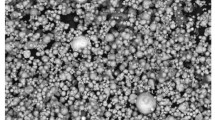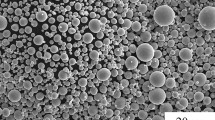Abstract
A 93 wt% W heavy alloy was injection molded into standard tensile test specimens and kinetic energy penetrators. Due to the relatively high activation energy of flow (124 kJ/mol), the rheological behavior of the molten feedstock was very susceptible to temperature variation. Using die sets with constant-volume die cavities, the tensile test specimens could be formed within a wide working window, whereas the penetrator could not be molded without defects because of different jetting phenomena during molding. The penetrator could be molded successfully using a die set whose die cavity progressively expanded during molding. The parts thus formed could subsequently be processed into intact components with full density and low carbon contents (<100 ppm). Their mechanical properties were comparable to or better than those of conventionally processed tungsten heavy alloys. Additional penetration test results indicated that powder injection molding was a viable route for processing high-performance tungsten heavy alloys.
Similar content being viewed by others
References
D.J. Jones and P. Munnery, Production of Tungsten Alloy Penetration Radiation Shields,Powder Metall., Vol 10, 1967, p 156–173
W.E. Gurwell, A Review of Embrittlement Mechanisms in Tungsten Heavy Alloys,Prog. in Powder Metallurgy, Vol 42, E.A. Carlson and G. Gaines, Ed., Metal Powder Industries Federation, 1986, p 569–590
B.C. Muddle, Interphase Boundary Precipitation in Liquid Phase Sintered W-Ni-Fe and W-Ni-Cu Alloys,Metall. Trans. A, Vol 15A, 1984, p 1089–1098
D.V. Edmonds and P.N. Jones, Interfacial Embrittlement in Liquid-Phase Sintered Tungsten Heavy Alloys,Metall. Trans. A, Vol 10A, 1979, p 289–295
W.D. Schubert, Aspects of Research and Development in Tungsten and Tungsten Alloys,Refract. Met. Hard Mater., Vol 11, 1992, p 151–157
T.W. Penrice, Development in Materials for Use as Kinetic Energy Penetrators,Powder Metallurgy in Defense Technology, Vol 5, Metal Powder Industries Federation, 1980, p 11–21
D. Chaiat, Future P/M Materials for Kinetic Energy Penetrators and Shape Charge Liners,Powder Metallurgy in Defense Technology, Vol 7, W.J. Ullrich, Ed., Metal Powder Industries Federation, 1987, p 185–197
R.M. German,Powder Injection Molding, Metal Powder Industries Federation, 1990, p 1–16
A. Bose, R.J. Dowding, and G.A. Allen, Powder Injection Molding of a 95W-4Ni-lFe Alloy,Powder Injection Molding Symposium—1992, P.H. Booker, J. Gaspervich, and R.M. German, Ed., Metal Powder Industries Federation, 1992, p 261–274
A. Bose, H. Zhang, P. Kemp, and R.M. German, Injection Molding of Molybdenum Treated Tungsten Heavy Alloys,Advances in Powder Metallurgy, Vol 3, E.R. Andreotti and P.J. McGeehan, Ed., Metal Powder Industries Federation, 1990, p 401–413
T.S. Wei and R.M. German, Injection Molded Tungsten Heavy Alloy,Int. J. Powder Metall., Vol 24, 1988, p 327–335
S.T. Lin and R.M. German, Properties of Fully Densified Injection Molded Carbonyl Iron,Metall. Trans. A, Vol 21 A, 1990, p 2531–2538
G.C. Sih, Progressively Expanding Molding with Single or Multiple Selection Controlling Volume Configuration and Rate of Injection Material: Metal or Polymer, U.S. Patent 5,505,896,1996
S.T. Lin and R.M. German, Extraction Debinding of Injection Molded Parts by Condensed Solvent,Powder Metall. Int., Vol 21, 1989, p 19–24
Y.S. Zu and S.T. Lin, “Optimizing the Mechanical Properties of Injection Molded W-4.9%Ni-2.1%Fe in Debinding,” National Taiwan Institute of Technology, Taipei, 1996
A. Bose and R.M. German, Sintering Atmosphere Effects on Tensile Properties of Heavy Alloys,Metall. Trans. A, Vol 19A, 1988, p 2467–2476
D.J. Williams,Polymer Science and Engineering, Prentice-Hall, 1972, p 340–355
Y.H. Chiou, S.J. Liu, and S.T. Lin, Superplastic Behaviour of a Zirconia Powder-Binder Blend,Ceram. Int., Vol 22,1996, p 35–41
P.H. Booker, “Paniculate Injection Molding of Selected Metal Alloys and Ceramics,” presented at 1991 Injection Molding International Symposium (Albany), Metal Powder Industries Federation, 15–17 July 1991
R.M. German, K.F. Hens, and S.T. Lin, Key Issues in Powder Injection Molding,Bull. Am. Ceram. Soc., Vol 70,1991, p 1294–1302
N. Piccirillo and D. Lee, Jetting Phenomena in Powder Injection Molding,Int. J. Powder Metall., Vol 28, 1992, p 13–25
Y.H. Chiou, Y.S. Zu, and S.T. Lin, Partition of Tungsten in the Matrix Phase for Liquid Phase Sintered 93% W-4.9%Ni-2.1 %Fe.,Scr. Mater., Vol 34,1996, p 135–140
R.M. German, J.E. Hanafee, and S.L. Digiallonardo, Toughness Variation Test Temperature and Cooling Rate for Liquid Phase Sintered W-3.5Ni-l.5Fe,Metall. Trans. A, Vol 15A, 1984, p 121–128
R.M. German and L.L. Bourguignon, Analysis of High Tungsten Content Heavy Alloys,Powder Metallurgy in Defense Technology, Vol 6, C.L. Freeby and W.J. Ullrich, Ed., Metal Powder Industries Federation, 1985,p 117–131
J.M. Sakai and C. Grabarek, Ballistic Tests on Heat Treated Tungsten Alloy Penetrator after Swaging,Powder Metallurgy in Defense Technology, Vol 4, Metal Powder Industries Federation, 1978, p 85–90
L.L. Bourguignon and R.M. German, Sintering Temperature Effects on Tungsten Heavy Alloys,Int. J. Powder Metall., Vol 24, 1988,p 115–121
J.B. Posthill, M.C. Hogwood, and D.V. Edmonds, Precipitation at Tungsten/Tungsten Interfaces in Tungsten-Nickel-Iron Heavy Alloys,Powder Metall., Vol 29, 1986, p 45–51
Author information
Authors and Affiliations
Rights and permissions
About this article
Cite this article
Zu, Y., Chiou, Y. & Lin, S. Performance of powder-injection-molded W-4.9Ni-2.1Fe components. JMEP 5, 609–614 (1996). https://doi.org/10.1007/BF02646090
Issue Date:
DOI: https://doi.org/10.1007/BF02646090




